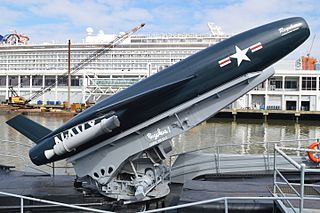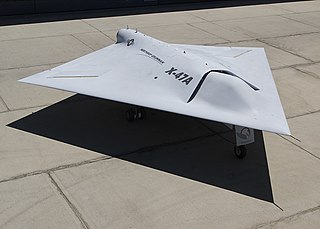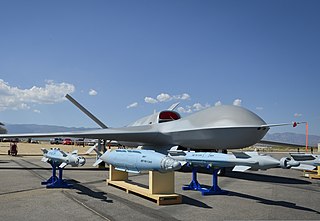
The SSM-N-8A Regulus or the Regulus I was a United States Navy-developed ship-and-submarine-launched, nuclear-capable turbojet-powered second generation cruise missile, deployed from 1955 to 1964. Its development was an outgrowth of U.S. Navy tests conducted with the German V-1 missile at Naval Air Station Point Mugu in California. Its barrel-shaped fuselage resembled that of numerous fighter aircraft designs of the era, but without a cockpit. Test articles of the Regulus were equipped with landing gear and could take off and land like an airplane. When the missiles were deployed they were launched from a rail launcher, and equipped with a pair of Aerojet JATO bottles on the aft end of the fuselage.

The Northrop Grumman X-47 is a demonstration unmanned combat aerial vehicle. The X-47 began as part of DARPA's J-UCAS program, and is now part of the United States Navy's UCAS-D program to create a carrier-based unmanned aircraft. Unlike the Boeing X-45, initial Pegasus development was company-funded. The original vehicle carries the designation X-47A Pegasus, while the follow-on naval version is designated X-47B.

Lockheed Have Blue was the code name for Lockheed's proof of concept demonstrator for a stealth fighter. Have Blue was designed by Lockheed's Skunk Works division, and tested at Groom Lake, Nevada. The Have Blue was the first fixed-wing aircraft whose external shape was defined by radar engineering rather than by aerospace engineering. The aircraft's faceted shape was designed to deflect electromagnetic waves in directions other than that of the originating radar emitter, greatly reducing its radar cross-section.

The BQM-74 Chukar is a series of aerial target drones produced by Northrop. The Chukar has gone through three major revisions, including the initial MQM-74A Chukar I, the MQM-74C Chukar II, and the BQM-74C Chukar III. They are recoverable, remote controlled, subsonic aerial target, capable of speeds up to Mach 0.86 and altitudes from 30 to 40,000 ft.

A flying submarine, submersible aircraft or aerosub is a combination of a seaplane and a submarine. It is supposed to be able both to fly and to travel under water. Taking-off from the surface of water is also intended.

The ADM-160 MALD is an air-launched, expendable decoy missile developed by the United States. Later variants (MALD-J) are additionally equipped with electronic countermeasures to actively jam early warning and target acquisition radars.
The High Energy Liquid Laser Area Defense System (HELLADS), is a counter-RAM system under development that will use a powerful (150 kW) laser to shoot down rockets, missiles, artillery and mortar shells. The initial system will be demonstrated from a static ground-based installation, but in order to eventually be integrated on an aircraft, the final design would require a maximum weight of 750 kg (1,650 lb) and a maximum envelope of 2 cubic meters (70.6 feet3).

The AUM-N-2 Petrel, also known as Kingfisher C and AUM-2, was an air-to-surface missile produced as part of Project Kingfisher for the United States Navy. Intended to use against enemy surface ships and surfaced submarines giving aircraft the ability to deliver aerial torpedoes from outside the range of defensive armament, it saw brief operational service in the late 1950s. The project was never considered a high priority by the Navy however, as it was useless against submerged submarines, which were considered the greatest potential threat.

The Boeing A160 Hummingbird is an unmanned aerial vehicle (UAV) helicopter. Its design incorporates many new technologies never before used in helicopters, allowing for greater endurance and altitude than any helicopter currently in operation.

The Northrop Grumman X-47B is a demonstration unmanned combat aerial vehicle (UCAV) designed for aircraft carrier-based operations. Developed by the American defense technology company Northrop Grumman, the X-47 project began as part of DARPA's J-UCAS program, and subsequently became part of the United States Navy's Unmanned Combat Air System Demonstration (UCAS-D) program. The X-47B is a tailless jet-powered blended-wing-body aircraft capable of semi-autonomous operation and aerial refueling.

The BAI Aerosystems (BAIA) BQM-147 Dragon unmanned aerial vehicle is a tactical battlefield UAV operated by the United States Marine Corps. Originally designed as an expendable communication jammers, they were converted into a reconnaissance role with the addition of a camera.

The MMIST CQ-10A SnowGoose is a cargo delivery unmanned aerial vehicle that has reached IOC with the United States Armed Forces with the delivery of 15 vehicles. The SnowGoose UAV is produced by the Canadian company Mist Mobility Integrated Systems Technology (MMIST). The SnowGoose UAV is an application of MMIST's Sherpa autonomous GPS-guided parafoil delivery system and is intended for pin-point delivery of small cargo items to special forces. A fully loaded Snowgoose can carry a total of 261 kg (575 lb). The SnowGoose was originally designed for leaflet dispensing for pychological warfare, but can support a variety of missions with its six modular cargo bays, each of which can carry pods for fuel, supplies, electronics packages, and provide aerial surveillance and communications relay.

The DRS RQ-15 Neptune is a reconnaissance UAV developed in the United States in the early years of the 21st century. The design is optimized for operations over water, and is capable of water landings on its flying boat–like hull. The 11.2 kW (15 hp) pusher engine is mounted high to keep it dry during takeoffs and landings. The Neptune can also be launched off a pneumatic catapult and land on a skid. In 2007, one was unsuccessfully launched off the USS Nashville (LPD-13), crashing into the water less than two seconds after lift off.

The General Atomics MQ-20 Avenger is a developmental unmanned combat aerial vehicle built by General Atomics Aeronautical Systems for the U.S. military.

The Boeing Phantom Eye was a high altitude, long endurance (HALE) liquid hydrogen-powered unmanned aerial vehicle developed by Boeing Phantom Works. The aircraft was Boeing's proposal to meet the demand from the US military for unmanned drones designed to provide advanced intelligence and reconnaissance work, driven by the combat conditions in Afghanistan in particular. In August 2016, the Phantom Eye demonstrator was disassembled for display at the Air Force Flight Test Museum.

The ASW Continuous Trail Unmanned Vessel (ACTUV) is a DARPA funded project launched in early 2010 to develop an anti-submarine drone. ASW is an acronym for Anti-Submarine Warfare. In January 2018 after successful sea trials it was announced that the "Sea Hunter" prototype has transitioned from DARPA to the Office of Naval Research for further development.

The Boeing MQ-25 Stingray is an aerial refueling drone that resulted from the Carrier-Based Aerial-Refueling System (CBARS) program, which grew out of the earlier Unmanned Carrier-Launched Airborne Surveillance and Strike (UCLASS) program. The MQ-25 first flew on 19 September 2019.

The Raytheon Coyote is a small, expendable, unmanned aircraft system built by the Raytheon Company, with the capability of operating in autonomous swarms. It is launched from a sonobuoy canister with the wings deploying in early flight phase.

The Bayraktar Kızılelma is a single-engine, low-observable, carrier-capable, jet-powered unmanned combat aerial vehicle (UCAV), currently in development by Turkish defense company Baykar. The aircraft is being developed as part of Project MIUS. The initial Bayraktar Kızılelma (Kızılelma-A) is subsonic. Planned variants are intended to be supersonic, the latter having a twin-engined configuration. It is one of the two Turkish jet-powered stealth UCAV along with TAI Anka-3.

The General Atomics Mojave is an unmanned aerial vehicle (UAV) capable of short takeoff and landing (STOL), being developed by General Atomics Aeronautical Systems. First unveiled on December 9, 2021, General Atomics states that it is to fulfill the roles of reconnaissance, close air support, and armed overwatch.



















